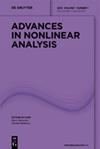Infinitely many non-radial solutions for a Choquard equation
IF 3.7
1区 数学
Q1 MATHEMATICS
引用次数: 5
Abstract
Abstract In this article, we consider the non-linear Choquard equation − Δ u + V ( ∣ x ∣ ) u = ∫ R 3 ∣ u ( y ) ∣ 2 ∣ x − y ∣ d y u in R 3 , -\Delta u+V\left(| x| )u=\left(\mathop{\int }\limits_{{{\mathbb{R}}}^{3}}\frac{| u(y){| }^{2}}{| x-y| }{\rm{d}}y\right)u\hspace{1.0em}\hspace{0.1em}\text{in}\hspace{0.1em}\hspace{0.33em}{{\mathbb{R}}}^{3}, where V ( r ) V\left(r) is a positive bounded function. Under some proper assumptions on V ( r ) V\left(r) , we are able to establish the existence of infinitely many non-radial solutions.一个Choquard方程的无穷多个非径向解
摘要本文考虑非线性Choquard方程- Δ u+V(∣x∣)u=∫R 3∣u (y)∣2∣x - y∣d y u在R 3中,- \Delta u+V \left (| x|)u= \left (\mathop{\int }\limits _ {{{\mathbb{R}}} ^{3}}\frac{| u(y){| }^{2}}{| x-y| }{\rm{d}} y \right)u \hspace{1.0em}\hspace{0.1em}\text{in}\hspace{0.1em}\hspace{0.33em}{{\mathbb{R}}} ^{3},其中V (R) V \left (R)是一个正有界函数。在V (r) V \left (r)的适当假设下,我们能够建立无穷多个非径向解的存在性。
本文章由计算机程序翻译,如有差异,请以英文原文为准。
求助全文
约1分钟内获得全文
求助全文
来源期刊

Advances in Nonlinear Analysis
MATHEMATICS, APPLIED-MATHEMATICS
CiteScore
6.00
自引率
9.50%
发文量
60
审稿时长
30 weeks
期刊介绍:
Advances in Nonlinear Analysis (ANONA) aims to publish selected research contributions devoted to nonlinear problems coming from different areas, with particular reference to those introducing new techniques capable of solving a wide range of problems. The Journal focuses on papers that address significant problems in pure and applied nonlinear analysis. ANONA seeks to present the most significant advances in this field to a wide readership, including researchers and graduate students in mathematics, physics, and engineering.
 求助内容:
求助内容: 应助结果提醒方式:
应助结果提醒方式:


